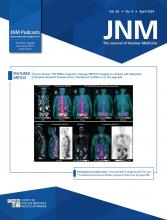Abstract
Immunotherapy is becoming the mainstay for treatment of a variety of malignancies, but only a subset of patients respond to treatment. Tumor-infiltrating CD8-positive (CD8+) T lymphocytes play a central role in anti-tumor immune responses. Non-invasive imaging of CD8+ T cells may provide new insights into the mechanisms of immunotherapy and potentially predict treatment response. We are studying the safety and utility of 89Zr-IAB22M2C, a radiolabeled minibody against CD8+ T cells, for targeted imaging of CD8+ T cells in patients with cancer. Methods: The intial dose escalation phase of this first-in-human prospective study included 6 patients (melanoma, 1; lung, 4; HCC, 1). Patients received approximately 111 MBq (3 mCi) of 89Zr-IAB22M2C (at minibody mass doses of 0.2, 0.5, 1.0, 1.5, 5, or 10 mg) as a single dose, followed by PET/CT scans at ~1-2, 6-8, 24, 48, and 96–144 h post-injection (p.i.). Biodistribution in normal organs, lymph nodes, and lesions was evaluated. In addition, serum samples were obtained at ~5, 30, and 60 min and later at the times of imaging. Patients were monitored for safety during infusion and up to the last imaging time point. Results: 89Zr-IAB22M2C infusion was well tolerated with no immediate or delayed side effects observed after injection. Serum clearance was typically bi-exponential and dependent on the mass of minibody administered. Areas under the serum time-activity curve normalized to administered activity ranged from 1.3 h/l for 0.2 mg to 8.9 h/l for 10 mg. Biodistribution was dependent on the minibody mass administered. The highest uptake was always seen in spleen, followed by bone marrow. Liver uptake was more pronounced with higher minibody masses. Kidney uptake was typically low. Prominent uptake was seen in multiple normal lymph nodes as early as 2 h p.i., reaching peak levels by 24–48 h p.i. Uptake in tumor lesions was seen on imaging as early as 2 h p.i., with a majority of 89Zr-IAB22M2C-positive lesions detectable by 24 h. Lesions were visualized early in patients receiving treatment, with SUV ranging from 5.85–22.8 in 6 target lesions. Conclusion: 89Zr-IAB22M2C imaging is safe and has favorable kinetics for early imaging. Biodistribution suggests successful targeting of CD8+ T cell-rich tissues. The observed targeting of tumor lesions suggests this may be informative for CD8+ T cell accumulation within tumors. Further evaluation is underway.
- Copyright © 2019 by the Society of Nuclear Medicine and Molecular Imaging, Inc.







